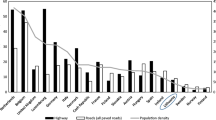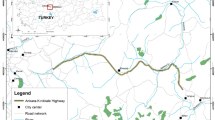Abstract
Wildlife-related accidents are a serious problem in different countries and describing their temporal pattern allows for the development of measures to mitigate them. We described the temporal pattern of wild ungulate-related accidents occurring between January 2006 and December 2010 in the Autonomous Region of Galicia, northwest of Spain. We examined the temporal distribution of the accidents according to months, phenological and hunting seasons, days of the week and time of the day. From the 6,255 wild ungulate-related traffic accidents analysed, 36.5% were related to roe deer Capreolus capreolus and 62.8% were related to wild boar Sus scrofa. The monthly distribution of accidents was not random but follows a characteristic pattern for each species. Roe deer-related accidents have their maximum in April and May, coinciding with the breeding season, followed by July, coinciding with the rut. Wild boar-related accidents have their maximum between October and January, coinciding with the hunting season but also with months with the longest nights. Both roe deer- and wild boar-related accidents showed an increase at weekends, specially on Sundays. During the hunting season, the wild boar-related accidents showed a marked peak on the same day. This weekly pattern was explained by drivers’ behaviour and by hunting. For roe deer, peaks of accidents occurred between 19:00 and 22:00 (about dusk) and between 05:00 and 08:00 (about dawn). For wild boar, 69% of accidents occurred between 18:00 and 23:00, coinciding with dusk and night. This daily pattern of accidents was explained by the behaviour of the species.





Similar content being viewed by others
References
Acevedo P, Escudero MA, Muñoz R, Gortázar C (2006) Factors affecting wild boar abundance across an environmental gradient in Spain. Acta Theriol 51:327–336
Aragón S, Braza F, San José C (1995) Socioeconomic, physiognomic, and climatic factors determining the distribution pattern of roe deer Capreolus capreolus in Spain. Acta Theriol 40:37–43
Banister D, Stead D, Steen P, Akerman J, Dreborg K, Nijkamp P, Schleicher-Tappeser R (2000) European transport policy and sustainable mobility. E & FN Spon, London
Bárcena F, Hermida R (2003) Mamíferos de Galicia. In: Otero Pedrayo R (ed) Enciclopedia galega. Editorial Novos Vieiros, A Coruña, pp 432–579
Boitani L, Mattei L, Nonis D, Corsi F (1994) Spatial and activity patterns of wild boars in Tuscany, Italy. J Mammal 75:600–612
Crooks KR (2002) Relative sensitivities of mammalian carnivores to habitat fragmentation. Conserv Biol 16:488–502
Danilkin A, Hewison AJ (1996) Behavioural ecology of European and Siberian roe deer. Chapman & Hall, London
Dussault C, Poulin M, Courtois R, Ouellet JP (2006) Temporal and spatial distribution of moose–vehicle accidents in the Laurentides Wildlife Reserve, Quebec, Canada. Wildl Biol 12:415–425
Dytham C (2003) Choosing and using statistics. A biologist’s guide. Blackwell, Malden
Eloff P, van Niekerk A (2008) Temporal patterns of animal-related traffic accidents in the Eastern Cape, South Africa. S Afr J Wildl Res 38:153–162
European Union Road Federation (2009) European road statistics 2009. Available at: http://www.irfnet.eu/index.php?option=com_content&view=article&id=262%3Aeuropean-road-statistics-2009&catid=17&Itemid=61. Accessed 25 May 2011
Fahrig L, Merriam G (1994) Conservation of fragmented populations. Conserv Biol 8:50–59
Fernández-Llario P, Mateos-Qusesada P, Silvério A, Santos P (2003) Habitat effects and shooting techniques on two wild boar (Sus scrofa) populations in Spain and Portugal. Z Jagdwiss 49:120–129
Ferreras P, Aldama JJ, Beltran JF, Delibes M (1992) Rates and causes of mortality in a fragmented population of iberian lynx Felis pardina Temminck, 1824. Biol Conserv 61:197–202
Finder RA, Roseberry JL, Woolf A (1999) Site and landscape conditions at white-tailed deer vehicle collision locations in Illinois. Landsc Urban Plan 44:77–85
Fuller DO, Williamson R, Jeffe M, James D (2003) Multi-criteria evaluation of safety and risks along transportation corridors on the Hopi Reservation. Appl Geogr 23:177–188
Garrett LC, Conway GA (1999) Characteristics of moose–vehicle collisions in Anchorage, Alaska, 1991-1995. J Saf Res 30:219–223
Groot Bruinderink WTAG, Hazebroek E (1996) Ungulate traffic collisions in Europe. Conserv Biol:1059–1067
Haikonen H, Summala H (2001) Deer–vehicle crashes—extensive peak at 1 hour after sunset. Am J Prev Med 21:209–213
Hartwig D (1991) Erfassung der Verkehrsunfälle mit Wild im Jahre 1989 in Nordrhein-Westfalen im Bereich der Polizeibehörden. Z Jagdwiss 37:55–62
Hartwig D (1993) Auswertung der durch Wild verursachten Verkehrsunfälle nach der Statistik für Nordrhein-Westfalen. Zeitschrift für Jagdwissenschaft 39:22–33
Hubbard M, Danielson B, Schmitz R (2000) Factors influencing the location of deer–vehicle accidents in Iowa. J Wildl Manage 64:707–713
Huijser MP, Duffield JW, Clevenger AP, Ament RJ, McGowen PT (2009) Cost–benefit analyses of mitigation measures aimed at reducing collisions with large ungulates in the United States and Canada: a decision support tool. Ecol Soc14: 15 [online] URL: http://www.ecologyandsociety.org/vol14/iss2/art15/
IGE (2009) Densidade da rede de Estradas. Available at: http://www.ige.eu/igebdt/selector.jsp?COD=473&paxina=001&c=0101001. Accesed 14 June 2011
IGE (2010) Territorio. Available at: http://www.ige.eu/web/mostrar_actividade_estatistica.jsp?idioma=gl&codigo=0101001. Accessed 23 May 2011
IGN (2006–2010) Available at: http://www.fomento.es/mfom/lang_castellano/direcciones_generales/instituto_geografico/astronomia/publico/efemerides/salida_puesta_sol.htm. Accessed 10 May 2011
Joyce T, Mahoney S (2001) Spatial and temporal distributions of moose–vehicle collisions in Newfoundland. Wildl Soc Bull 29:281-291
Langbein J (2007) National deer–vehicle collisions project: England 2003–2005. Final report to the Highways Agency. The Deer Initiative, Wrexham, UK
Langbein J, Putman RJ (2006) Deer–vehicle collisions project; Scotland, 2003–2005. Report to the Scottish Executive, June 2006
Langbein J, Putman R, Pokorny B (2011) Traffic collisions involving deer and other ungulates in Europe and available measures for mitigation. In: Putman R, Apollonio M, Andersen R (eds) Ungulate management in Europe: problems and practices. Cambridge University Press, pp 215–259
Liberg O, Johansson A, Andersen R, Linnell JDC (1998) Mating system, mating tactics and the function of male territoriality in roe deer. In: Andersen R, Duncan P, Linnell JDC (eds) The European roe deer: the biology of success. Scandinavian University Press, Oslo, pp 221–256
Linnell JDC, Wahlström K, Gaillard J-M (1998) From birth to independence: birth, growth, neonatal mortality, hiding behaviour and dispersal. In: Andersen R, Duncan P, Linnell JDC (eds) The European roe deer: the biology of success. Scandinavian University Press, Oslo, pp 257–283
Madsen AB, Strandgaard H, Prang A (2002) Factors causing traffic killings of roe deer Capreolus capreolus in Denmark. Wildl Biol 8:55–61
Maillard D, Fournier P (1995) Effects of shooting with hounds on size of resting range of wild boar (Sus scrofa L.) groups in Mediterranean habitat. Ibex J Mt Ecol 3:102–107
Martínez Cortizas A, Pérez Alberti A (2000) Atlas Climático de Galicia. Xunta de Galicia, Consellería de Medio Ambiente, Santiago de Compostela
Mateos Quesada P (2002) Biología y comportamiento del Corzo Ibérico. Universidad de Extremadura, Cáceres
Mateos-Quesada P (2005) Corzo - Capreolus capreolus. Enciclopedia Virtual de los Vertebrados Españoles. Museo Nacional deCiencias Naturales, Madrid. http://www.vertebradosibericos.org/
Ministerio de Fomento (2009) Anuario estadístico 2009. Available at: http://www.fomento.gob.es/MFOM/LANG_CASTELLANO/ESTADISTICAS_Y_PUBLICACIONES/INFORMACION_ESTADISTICA/EstadisticaSintesis/Anuario/default.htm. Accessed 20 May 2011
Mysterud A (2004) Temporal variation in the number of car-killed red deer Cervus elaphus in Norway. Wildl Biol 10:203–211
Ng JW, Nielsen C, St C, Clair C (2008) Landscape and traffic factors influencing deer–vehicle collisions in an urban enviroment. Hum Wildl Confl 2:34–47
Pallant JM (2005) SPSS survival manual. A step by step guide to data analysis using SPSS version 12. Open University Press, Buckingham
Pokorny B (2006) Roe deer–vehicle collisions in Slovenia: situation, mitigation strategy and countermeasures. Vet Arhiv (Suppl) 76:177–187
Putman RJ (1997) Deer and road traffic accidents: options for management. J Environ Manage 51:43–57
Ramp D, Caldwell J, Edwards KA, Warton D, Croft DB (2005) Modelling of wildlife fatality hotspots along the snowy mountain highway in New South Wales, Australia. Biol Conserv 126:474–490
Romin L, Bissonette J (1996) Temporal and spatial distribution of highway mortality of mule deer on newly constructed roads at Jordanelle Reservoir, Utah. Great Basin Nat 56:1–11
Rosell C, Fernández-Llario P, Herrero J (2001) El jabalí (Sus scrofa Linnaeus, 1758). Galemys 13:1–25
Rosell C, Álvarez G, Cahill C, Campeny C, Rodríguez A, Séiler A (2002) COST 34. La fragmentación del hábitat en relación con las infraestructuras de transporte en España. Ministerio de Medio Ambiente. Informe inédito, Madrid
Russo L, Massei G, Genov PV (1997) Daily home range and activity of wild boar in a Mediterranean area free from hunting. Ethol Ecol Evol 9:287–294
Sáez-Royuela C, Tellería JL (1986) The increased population of the wild boar (Sus scrofa L.) in Europe. Mamm Rev 16:97–101
Scillitani L, Monaco A, Toso S (2010) Do intensive drive hunts affect wild boar (Sus scrofa) spatial behaviour in Italy? Some evidences and management implications. Eur J Wildl Res 56:307–318
Seiler A (2004) Trends and spatial patterns in ungulate–vehicle collisons in Sweden. Wildl Biol 10:301–313
Sempéré AJ, Sokolov VE, Danilkin AA (1996) Capreolus capreolus. Mamm Species 538:1–9
Silva-Pando FJ, Rozados Lorenzo MJ, González Hernández MP (2002) Grasslands and scrublands in the northwest of the Iberian Peninsula: silvopastoral systems and nature conservation. In: Redecker B, Finck P, Härdtle W, Riecken U, Schröder E (eds) Pasture landscapes and nature conservation. Springer, Berlin, pp 271–284
Sodeikat G, Pohlmeyer K (2003) Escape movements of family groups of wild boar Sus scrofa influenced by drive hunts in Lower Saxony, Germany. Wildl Biol 9:43–49
Sodeikat G, Pohlmeyer K (2007) Impact of drive hunts on daytime resting site areas of wild boar family groups (Sus scrofa L.). Wildl Biol Pract 3:28–38
Underhill JE, Angold PG (2000) Effects of roads on wildlife in an intensively modified landscape. Environ Rev 8:21–39
Xunta de Galicia (2010) Memoria de Tráfico da Rede Autonómica de Estradas de Galicia 2010. Available at: http://cmati.xunta.es/portal/webdav/site/cptopv/shared/es/pdfs/dxop/Memoria10.pdf. Accessed 25 May 2011
Acknowledgements
This research was supported by the project “Proyecto de I + D sobre accidentes y daños causados por la presencia de animales en la red autonómica de carreteras de Galicia”, financed by Consellería de Medio Ambiente, Territorio e Infrastructuras (CMATI). We are grateful to María Isabel Berriuso, Antonio López and Jose Ramón Pacheco (CMATI) for their special collaboration. Fernando Lago, Víctor Estévez and Rodrigo Souto contributed to process the data. We thank Mari Carmen Iglesias (Universidad of Vigo) for her guidance and useful comments about the statistical analysis. We thank Martyn Rich for revising the English version.
Author information
Authors and Affiliations
Corresponding author
Additional information
Communicated by C. Gortázar
Rights and permissions
About this article
Cite this article
Lagos, L., Picos, J. & Valero, E. Temporal pattern of wild ungulate-related traffic accidents in northwest Spain. Eur J Wildl Res 58, 661–668 (2012). https://doi.org/10.1007/s10344-012-0614-6
Received:
Revised:
Accepted:
Published:
Issue Date:
DOI: https://doi.org/10.1007/s10344-012-0614-6




